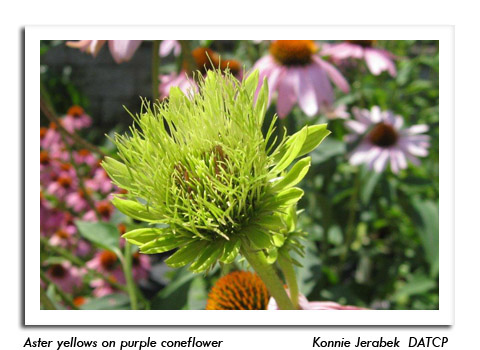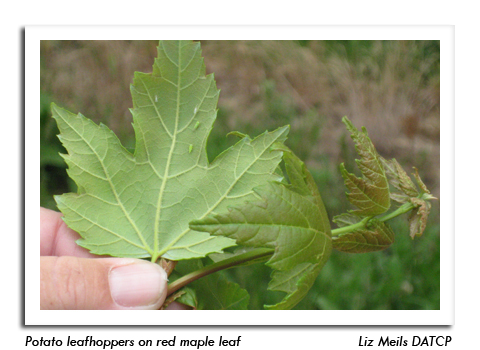
 |
|
|
Nursery & Forest
Volume 57 Number 15 Date 07/26/2012 ASTER YELLOWS - This aster leafhopper-transmitted disease was found on Echinacea 'Alba White Swan' and 'Pink Double Delight' at a nursery in Sawyer County. Symptoms of infection include abnormal flowers, irregular stem growth, and green, stunted ray and disk petals. The aster yellows phytoplasma persists in both wild and cultivated coneflowers and other perennial or biennial hosts over the winter months, thus infected plants may act as reservoirs next spring. Removal and destruction of symptomatic plants is the recommended control method. POTATO LEAFHOPPER - Red maples, white and green ash and honey locust trees in Bayfield, Oneida, Ozaukee and Washington counties are showing leaf cupping and tip-burn, typical symptoms of potato leafhopper feeding injury. Activity and reproduction by this insect is favored during periods of hot, dry weather and densities have been comparatively high this summer. Treatment of nursery stock is justified when nymphs and adults are present and symptoms are obvious. FLEA BEETLE - Several species of flea beetles were observed on hydrangea, weigela and a variety of other plants at garden centers in Outagamie and Ozaukee counties. Their pattern of feeding results in shallow pits and small rounded, irregular holes. Heavy feeding can cause wilted or stunted plants. Most flea beetles prefer vegetable crops, but some also feed on ornamental flowers, shrubs and trees. When populations reach damaging levels, there are a range of cultural, physical, biological and insecticidal options available for their control. RHIZOSPHAERA NEEDLECAST - Discoloration of both Colorado blue and white spruce trees in Oneida and Outagamie counties has been attributed to this fungal disease, characterized by browning and early needle loss starting on the lower branches. Needles are infected in spring, turn yellow in July, and then become purplish-brown by late summer and fall. Spruce trees may be treated with a fungicide in spring when the new growth reaches ½-2 inches long, and again 4-6 weeks later to prevent infection. --Liz Meils, DATCP Nursery Inspector 


|
|
|